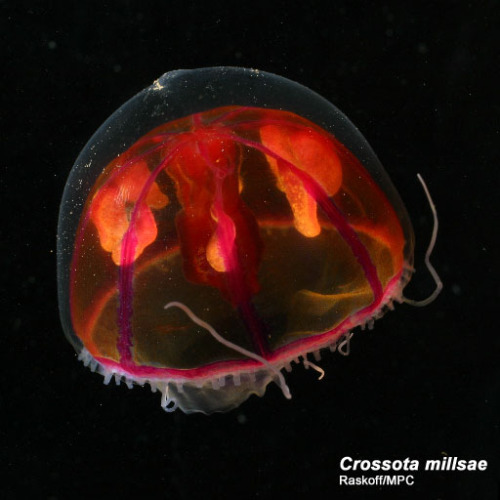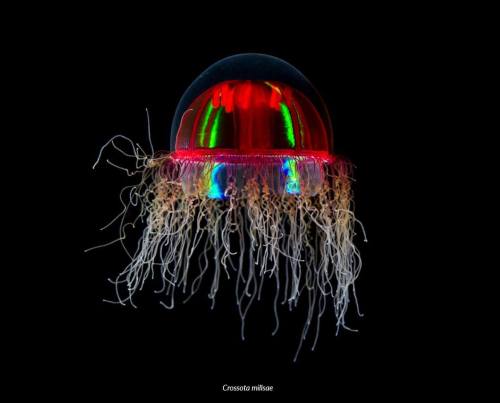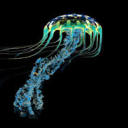Periphyllopsis Braueri

Periphyllopsis braueri
The Periphyllopsis braueri is a tiny, deep sea jellyfish that is only 6 cm in diameter. It is red-chocolate in color, and it has eight gonads. Furthermore, it is found at depths between 600m to 1000m.
Photo credit: https://oceanexplorer.noaa.gov/explorations/19gulfofalaska/logs/aug2/aug2.html
More Posts from Bioluminescentoceangoddess and Others

Black- eyed squid
Gonatus onyx
The Black-eyed Squid is roughly over one foot (35 am) and is found at depths as deep as 2500m. The female Black-eyed Squid works fiercely to protect her babies, by carrying around a patch of egg for six to nine months. When the eggs hatch, 2000 to 3000 babies are released into the ocean. However, this makes her vulnerable to predators.
Photocredit: http://tolweb.org/Gonatus+onyx/19769


Silky Medusa
Colobonema sericeum
The Silky Medusa is a gentle and reserved jellyfish; it has white-tipped tentacles that have the ability to detach from its body and bioluminescence when attacked by predators. It can be found drifting between 500 m to 1500 m. Furthermore, it consumes small crustaceans.
Photo credit: https://twitter.com/mbari_news/status/949736123760340994
https://www.montereybayaquarium.org/animals/animals-a-to-z/midwater-jelly


Spookfish
Winteria telescopa
The Spookfish’s eyes act as a telescope and are designed to maximize light in the deep ocean. Its eyes contain rod cells that help distinguish between ambient light and bioluminescent light. This adaptation helps avoid predators and catch prey.
Picture Credit: https://www.natureplprints.com/deep-sea/deep-sea-fish-winteria-telescopa-15230734.html


Pink Helmet
Aglantha digitale
The Pink Helmet is a mini hydromedusa that comes in a variety of vibrant colors. The tiny jelly is only 4 cm in size and is found towards the surface of the ocean. The purple and blue hues we see in its bell are caused by a phenomenon known as iridescence, when light strikes the jelly’s thin tissue at different angles (similar to what we see in a soap bubbles). It also has orange pigmentation near its mouth; this pigmentation helps attract prey and mask luminescence. Furthermore, females tend to be more colorful than males.
Photo credit: https://biolum.eemb.ucsb.edu/organism/pictures/aglantha.html
https://www.pinterest.com/pin/186899453255850798/


Glowing sucker octopus
Stauroteuthis syrtensis
The Glowing Sucker Octopus can be found at 2500 m in the deep ocean. This unique creature has two fins that look similar to elephant ears. They move elegantly through the water by moving these fins and contracting their mantle. Evidence of this creature has only been spotted in the Atlantic Ocean.
Photo credit: https://octolab.tv/species/glowing-sucker-octopus/
https://ferrebeekeeper.wordpress.com/2011/03/14/glowing-sucker-octopus/


Wolftrap Angler
Thaumatichthys binghami
The Wolftrap Angler is slightly different from many other species of anglers. It has its bioluminescent lure located inside of its mouth instead of connected to its body. Even though it is intimidating up close, it is only nine centimeters in size. It is found in the deep ocean at 2432m.
Photo credit
https://en.wikipedia.org/wiki/Thaumatichthys_binghami
https://igniteyourcuriosity.wordpress.com/2016/10/22/anglerfish/


Gulper Eel
Saccopharynx sp.
The Gulper Eel is known for its massive jaws, which are capable of swallowing prey whole. It’s stomach is also able to expand twice its size. It is found only in the deep see about 2000 to 3000 meters in depth.
Photo credit: https://www.youtube.com/watch?v=XRO0IjSoHGA
https://marinebiochemistrygc2018.weebly.com/deep-sea-adaptations


Psychedelic Medusa
Crossota millsae
The Psychedelic Medusa is a deep-sea hydrozoan that is abundant in the North Pacific. The mini-jelly is found at depths between 1000m to 3800m, and are often observed drifting near the ocean floor. It also has an eccentric reproduction behavior uncommon in cnidarians. The females display viviparity, and carry the babies in her bell until they are ready to hatch.
Photo credit: http://www.arcodiv.org/watercolumn/cnidarian/Crossota_millsae.html
https://twitter.com/spothvegr/status/1030177493075079169

Black Medusa
Vampyrocrossota childressi
The Black Medusa is an inky, black hydrozoan that absorbs all light that hits its tiny body. It has a translucent gelatin and a black umbrella; it is also only 1.5 cm in size. Moreover, it is found at depths between 600m to 1500m, and it spends its entire life floating in the deep ocean.
Photo credit: https://www.pinterest.com/pin/488148047080475827/


Pacific Viperfish
Chauliodus macouni
The Pacific Viperfish looks intimidating with its sharp, pointy teeth and large jaws. However, its body is small and elongated. It can be found at depths ranging from 250m to 4390m. The Pacific Viperfish long teeth are an unique adaptation designed to keep prey trapped, but it is dangerously close to its eyes. There have been instances when they have caught prey that are too large to swallow and it dies along with its last meal. The Pacific Viper also has photophores along its body and a light organ near its dorsal fin. These organs exhibit bioluminescence and help with attracting pray: as well as, communicating with mates and confuse predators. It is one of the most ferocious predators of the deep ocean.
Photo credit: https://www.science-rumors.com/top-20-pacific-viperfish-facts-to-know-what-this-creature-is/
https://goldfisho.com/everything-you-need-to-know-about-viperfish/
-
 smurfyscott liked this · 1 year ago
smurfyscott liked this · 1 year ago -
 absolutesciencefiction reblogged this · 1 year ago
absolutesciencefiction reblogged this · 1 year ago -
 mycellpics liked this · 1 year ago
mycellpics liked this · 1 year ago -
 androidsghost liked this · 1 year ago
androidsghost liked this · 1 year ago -
 stardustandmoonflowers liked this · 1 year ago
stardustandmoonflowers liked this · 1 year ago -
 stuffinsweets liked this · 2 years ago
stuffinsweets liked this · 2 years ago -
 spooky-alien liked this · 2 years ago
spooky-alien liked this · 2 years ago -
 colorlessshado3 liked this · 2 years ago
colorlessshado3 liked this · 2 years ago -
 goblincreature808 liked this · 2 years ago
goblincreature808 liked this · 2 years ago -
 donuts4evry1 liked this · 2 years ago
donuts4evry1 liked this · 2 years ago -
 dailyjellyfish reblogged this · 2 years ago
dailyjellyfish reblogged this · 2 years ago -
 guessguesswho liked this · 2 years ago
guessguesswho liked this · 2 years ago -
 saltmatchescandlewax reblogged this · 2 years ago
saltmatchescandlewax reblogged this · 2 years ago -
 soft-fuzzy-communist liked this · 2 years ago
soft-fuzzy-communist liked this · 2 years ago -
 brittanygca liked this · 3 years ago
brittanygca liked this · 3 years ago -
 aphid-kirby liked this · 3 years ago
aphid-kirby liked this · 3 years ago -
 low-level--00 reblogged this · 3 years ago
low-level--00 reblogged this · 3 years ago -
 low-level--00 liked this · 3 years ago
low-level--00 liked this · 3 years ago -
 deadassdiaspore reblogged this · 3 years ago
deadassdiaspore reblogged this · 3 years ago -
 saucerkommand liked this · 3 years ago
saucerkommand liked this · 3 years ago -
 deadassdiaspore liked this · 3 years ago
deadassdiaspore liked this · 3 years ago -
 deadassdiaspore reblogged this · 3 years ago
deadassdiaspore reblogged this · 3 years ago -
 rabbitsartcorner liked this · 3 years ago
rabbitsartcorner liked this · 3 years ago -
 battlemage94 liked this · 3 years ago
battlemage94 liked this · 3 years ago -
 dbssh liked this · 3 years ago
dbssh liked this · 3 years ago -
 shiny-aesthetic liked this · 3 years ago
shiny-aesthetic liked this · 3 years ago -
 algaejay liked this · 3 years ago
algaejay liked this · 3 years ago -
 cum--brulee liked this · 3 years ago
cum--brulee liked this · 3 years ago -
 snickeringdragon liked this · 3 years ago
snickeringdragon liked this · 3 years ago -
 psionic--drain liked this · 3 years ago
psionic--drain liked this · 3 years ago -
 celestebescond liked this · 3 years ago
celestebescond liked this · 3 years ago -
 1eldiablo6 liked this · 3 years ago
1eldiablo6 liked this · 3 years ago -
 jerrielzapata liked this · 3 years ago
jerrielzapata liked this · 3 years ago -
 sewer-dweller liked this · 3 years ago
sewer-dweller liked this · 3 years ago -
 astrotracksuitbattalion liked this · 3 years ago
astrotracksuitbattalion liked this · 3 years ago -
 calamitycrash liked this · 3 years ago
calamitycrash liked this · 3 years ago -
 gothfrog-44 liked this · 3 years ago
gothfrog-44 liked this · 3 years ago -
 despair-with-walnuts liked this · 3 years ago
despair-with-walnuts liked this · 3 years ago -
 leecouchette liked this · 3 years ago
leecouchette liked this · 3 years ago -
 windyboysworld liked this · 3 years ago
windyboysworld liked this · 3 years ago -
 thenerdysamurai liked this · 3 years ago
thenerdysamurai liked this · 3 years ago -
 timetravelingsponger reblogged this · 3 years ago
timetravelingsponger reblogged this · 3 years ago -
 gooopy reblogged this · 3 years ago
gooopy reblogged this · 3 years ago -
 gooopy liked this · 3 years ago
gooopy liked this · 3 years ago -
 georgewalt liked this · 3 years ago
georgewalt liked this · 3 years ago -
 docegrotesco liked this · 3 years ago
docegrotesco liked this · 3 years ago

Bioluminescence is a chemical reaction that produces light. Many deep sea animals use bioluminescence. This blog is dedicated to educating the public about the amazing creatures that thrive in the deep sea.
57 posts